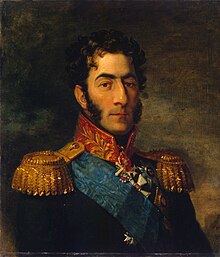
Back بيوتر باغراتيون Arabic بايجراتيون بيوتر ARZ Багратион, Иванил Пётр AV Пётр Іванавіч Баграціён Byelorussian Пётар Багратыён BE-X-OLD Пьотър Багратион Bulgarian Piotr Bagration Catalan Pjotr Ivanovič Bagration Czech Pjotr Iwanowitsch Bagration German Πιότρ Μπαγκρατιόν Greek
Pyotr Ivanovich Bagration | |
|---|---|
 Portrait by George Dawe | |
| Native name | პეტრე ბაგრატიონი |
| Nickname(s) | "God of the Army"[1] "The Eagle"[citation needed] |
| Born | 10 July 1765 Kizlyar,[2] Astrakhan Governorate, Russian Empire |
| Died | 24 September [O.S. 12 September] 1812 (aged 47) Sima, Vladimir Governorate, Russian Empire |
| Buried | |
| Allegiance | |
| Service/ | Imperial Russian Army |
| Years of service | 1782–1812 |
| Rank | General of the Infantry |
| Commands held |
|
| Battles/wars |
|
| Awards | Weapons: |
| Spouse(s) | Catherine Bagration née Skavronskaya |
| Relations | Ivane (father) Roman and Alexander (brothers) and Pyotr (nephew) |
| Signature | |
Prince Pyotr Ivanovich Bagration[nb 1] (10 July 1765 – 24 September 1812) was a Russian general and prince of Georgian origin, prominent during the French Revolutionary and Napoleonic Wars.
Bagration, a member of the Bagrationi dynasty, was born in Kizlyar.[2] His father, Ivan (Ivane), served as an officer in the Imperial Russian Army, in which Bagration also enlisted in 1782. Pyotr Ivanovich Bagration began his military career serving in the Russo-Circassian War of 1763–1864 for a couple of years. Afterwards he participated in a war against the Ottomans and the capture of Ochakov in 1788. Later he helped suppress the Kościuszko Uprising of 1794 in Poland and capture Warsaw. During Russia's Italian and Swiss campaigns of 1799 against the French, he served with distinction under Field Marshal Alexander Suvorov.
In 1805 Russia joined the coalition against Napoleon. After the collapse of the Austrians at Ulm in October 1805, Bagration won praise for his successful defense in the Battle of Schöngrabern (November 1805) that allowed Russian forces to withdraw and unite with the main Russian army of Mikhail Kutuzov. In December 1805 the combined Russo-Austrian army suffered defeat at the Battle of Austerlitz, where Bagration commanded the allied right wing against the French under Jean Lannes. Later he commanded Russian troops in the Finnish War (1808–1809) against Sweden and in another war against the Turks (1806–1812) on the Danube.
During the French invasion of Russia in 1812, Bagration commanded one of two large Russian armies (Barclay de Tolly commanded the other) fighting a series of rear-guard actions. The Russians failed to stop the French advance at the Battle of Smolensk in August 1812. Barclay had proposed a scorched-earth retreat that the Emperor Alexander I of Russia had approved, although Bagration preferred to confront the French in a major battle. Mikhail Kutuzov succeeded Barclay as Commander-in-Chief but continued his policy until the Battle of Borodino (7 September [O.S. 26 August] 1812) near Moscow. Bagration commanded the left wing around what became known as the Bagration flèches at Borodino, where he was mortally wounded; he died a couple of weeks later. Originally buried at a local church, in 1839 he was reburied on the battlefield of Borodino.
- ^ Mikaberidze (2009), Ch. XIII: Bagration – "God of an Army".
- ^ a b Pluchart (1835), pp. 60—61
Cite error: There are <ref group=nb> tags on this page, but the references will not show without a {{reflist|group=nb}} template (see the help page).
© MMXXIII Rich X Search. We shall prevail. All rights reserved. Rich X Search